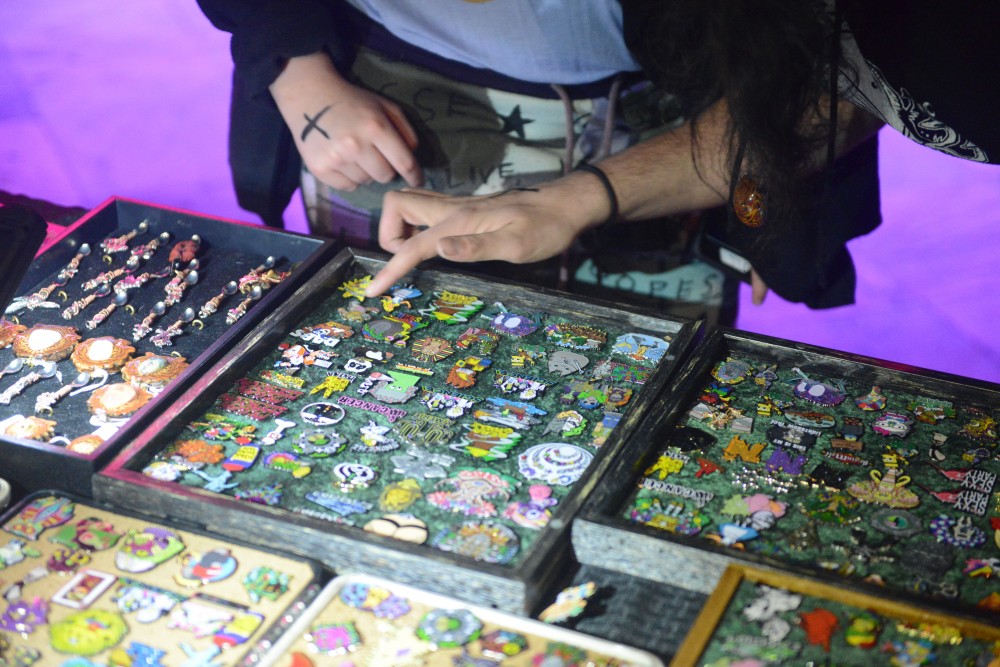Over the last half decade in the EDM scene, the Tuttrup brothers started to notice colorful, soft enamel pins featuring intricate artist logos, music festival designs and pop culture references on the hats and outfits of more and more show attendees.
“We could do that or even better,” said Carson Tuttrup, a graphic design first year University of Minnesota. “Why not just make them ourselves?”
So that’s what he and his brother, Spencer, did.
“Art is a huge thing in EDM,” said Spencer, who studies business entrepreneurship, graphic design and cross media graphics at Minnesota State University Mankato. “Pin design, creation and individualism can all represent artists that everyone collectively likes.”
Taking that idea and combining their skills, the Tuttrups started their business and design collective, CSthetics, in March. So far they’ve made parody pins of two popular DJs: Marshmello and Slushii. They’re currently working on four more designs.
“It’s a very interlocking, different community in the EDM scene,” Spencer said. “You have the Kandi Kids, the gloving and flow artists and then you have people that collect pins.”
While pins aren’t anything new, the market for DIY and larger pin producers has grown in recent years.

The Tuttrups work through local Twin Cities company Festi Daze. Owner Jordan Durand got started just like they did: after collecting pins for around four years, he decided to start his own business. Now, many of his pins are designed by local “kids.”
“A lot of these kids have these great ideas, they can do this art and just don’t know what to do with it,” Durand said. “They contact me and I help them turn their art into something they can actually feel, touch and look at.”
He said this tangible element is something pin collectors love, and the people involved only help the culture grow.
“For every person I see that is collecting pins, I see one new person buy their first pin,” he said. “This scene is constantly growing, and I don’t think it’s going to be going anywhere anytime soon.”
As their reach grows, some connect these pins to “raver kids” and drug culture, which can give them a negative reputation. However, many who collect pins don’t fall into that category.
Spencer said only the extreme sides of the EDM spectrum give pins a bad name.
“I always have a pin on my hat, and it’s in support of our art,” he said. “It depends on who wears it and how you wear it, I guess. It’s more of an artistic representation.”
Despite any reputation, the act of collecting and trading pins has been associated with music for decades, most notably by Deadheads. Today, pins have gained further momentum in pop culture, especially in online shops like Etsy and PINTRILL.
On these websites, the popular “Fear and Loathing in Las Vegas” character Raoul Duke can be found immortalized in enamel with his visor, cigarette and briefcase. Even emojis can be pinned to clothing: best sellers include the peach, “100” and smiling new moon designs.
Regardless, the question still stands — why do people collect and pin these musical and pop culture designs on themselves in the first place?
Carson said pins fully encompass ideas of personal “branding” and creative expression, concepts the Tuttrups have held onto when designing.
“That’s what we’re doing with our pins,” Carson said. “We’re taking the brands that we like and the pins that we enjoy, and then we add a little bit of our own personal flair to them.”
No matter the reason, these fun and creative art pieces are being pinned down by many.
“I think that’s why people like pins — because they’re different enough, and that’s cool,” Carson said. “Represent the things you love, but then have your own little twist on it.”








